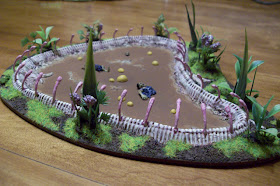In the first article I built up the borders of the digestion pool and in the second article I added the poisoned fronds and the gooey inside walls of the pool. In this article I will be adding the vegetation to the bases and paint up the pool.
Step 1:
The first thing I did was cut off some segments from a variety of plastic plants that I picked up at Michael's art and craft store. They have a wide variety of plastic plants that range in price from 2.99 - 9.99 dollars but many times they are marked up to 40% off. Here I cut an assortment of plant ends.
Step 2:
Many times when I am working with air-hardening clay, I save the left over pieces that are too small to put back with the rest of the brick so I usually break it up into smaller chunks and let it dry. Then later on I have a ready source of odd-shaped clay pieces that can fill in as rubble, stone, or mounds of earth. So for this part I needed something that would house the plastic plants I cut up in the previous step. I could have used styrofoam but I wanted something that would be durable and put up well with lots of use and storage. Here I took a chunk of clay and whittled the edges a bit to get a look that resembles a rock formation.
Then, with an assortment of drill heads I drilled in holes that would allow the stems of the plastic plants to fit in comfortably.
This is how it looks with the plant stems inserted into the pre-drilled holes. At this point I just placed the stems in to see how the arrangement looks. I do not glue them in at this point.
 |
| It helps to test out the positioning of the plants prior to gluing them to the board |
 |
| The kitty tried to approve of the plants but fell victim to the warm sunlight |
Step 3:
Next I dry brushed all of the clay bases to match the earth tone I created earlier. Then I added grass flock and green clumps to represent bushes. Then I glued down the air bubbles and then painted them and the decomposing bodies within the pool.
The bodies are part of the zombie crew that pushes the Vampire Counts corpse cart. I just sanded down the back sides so that they sit flush with the surface of the pool. The air bubbles are made from dried clay balls. Again, rather than toss out the left over pieces of wet clay, I rolled them into various sizes of beads and let them dry. When dried I gently sanded them down into half circles.
 |
| Air bubbles made from clay beads |
At this point the only thing left to do is add the water effects but at the time of typing this article I have yet to pick up a bottle. Once that is done I will include some pictures in a future post.
Be sure to check back next week as I continue with the Tyranid terrain series. Keep those ideas and suggestions coming!















Looks awesome mate
ReplyDeleteCannot wait to see the water effects - this also fits the bill perfecty for dangerous terrain.
ReplyDelete